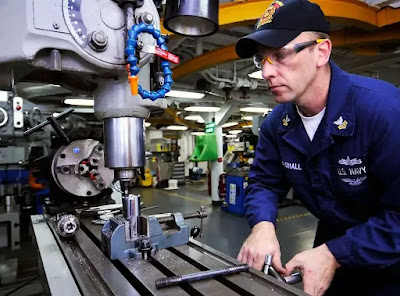The Machining Process and the Different Types of Machining Operations !
Introduction:
There are many different types of machining operations, each of which can produce a different part geometry and surface texture.Turning and milling are the two most common machining techniques. Other processes may be included into or done independently of these processes. A drill bit, for example, can be mounted on a turning lathe or tossed into a drill press. Previously, there was a distinction between turning, in which the part turns, and milling, in which the tool revolves. With the introduction of machining centres and turning centres that can conduct all of the functions of many machines in a single machine, this distinction has become somewhat blurred.
1.
Turning:
1.
Turning
A single point turning tool rotates axially down the side of the
workpiece, removing material to generate various characteristics such as steps,
tapers, chamfers, and contours. Typically, these features are machined with a
shallow radial depth of cut and many passes until the end diameter is reached.
2.
Facing
A single-point turning tool rotates radially around the
workpiece's end, removing a small layer of material to create a smooth flat
surface. The face's depth, which is normally very small, can be machined in a
single pass or by making successive passes at a reduced axial depth of cut.turnin operations
3. Grooving
A single-point turning tool cuts a groove the same width as the cutting tool by moving radially into the side of the workpiece. Multiple cuts can be performed to build grooves that are larger than the tool width, and specific form tools can be used to generate grooves with different geometries.
4.
Cut-off
A single-point cut-off tool advances radially into the side of the
workpiece, similar to grooving, and continues until the workpiece's centre or
inner diameter is reached, thus parting or cutting off a segment of the
workpiece.
5.
Thread cutting
A single-point threading tool glides axially down the side of the
workpiece, cutting threads into the outside surface, usually with a 60 degree
pointed nose. Threads can be cut to a specific length and pitch, and thread
formation may need numerous passes.
6.
Drilling
7.
Boring
 |
| turning operations |
8.
Reaming
A reamer enlarges an existing hole to the diameter of the tool by
entering the workpiece axially through the end. Reaming removes only a small
amount of material and is frequently used after drilling to get a more precise
diameter and a better internal finish.
9.
Tapping
A tap cuts internal threads into an existing hole by entering the
workpiece axially through the end. The appropriate tap drill size that will
accept the desired tap is normally drilled into the existing hole.
2.
Milling:
is the process of removing material from a workpiece by advancing a cutter into it with rotary cutters. This can be accomplished by changing the direction[2] of one or more axes, as well as the cutter head speed and pressure. [3] Milling encompasses a wide range of procedures and machinery, ranging from small single pieces to huge, heavy-duty gang milling operations. It's one of the most used methods for producing custom parts with tight tolerances. A variety of machine tools can be used to mill. The milling machine was the first type of machine tool for milling (often called a mill). Milling machines evolved into machining centres after the introduction of computer numerical control (CNC) in the 1960s: milling machines with automatic tool changers, tool changers, and tool changers. Enclosures, tool magazines or carousels, CNC capabilities, cooling systems Vertical machining centres (VMCs) and horizontal machining centres (HMCs) are the two types of milling centres (HMCs).
3.
Drilling:
Drilling uses drill
bits to generate cylindrical holes in solid materials; it is one of the most
significant machining techniques since the holes created are typically used to
aid with assembly. Drill presses are frequently employed, however lathes can also
be used. Drilling is a preparatory step in most manufacturing operations for
producing finished holes, which are then tapped, reamed, bored, etc. to
generate threaded holes or bring hole dimensions within acceptable tolerances.
Due to the bit's flexibility and tendency to seek the route of least
resistance, drill bits will typically cut holes larger than their nominal size
and holes that are not always straight or round.
As a result, drilling is frequently specified undersize. After that, another machining operation is performed to get the hole to its final size.
Types of drilling machines
Drilling machines come in a variety of shapes and sizes, depending on the type of operation, amount of feed, cut depth, spindle speeds, spindle movement method, and needed accuracy.The following are the various types of drilling machines:
1. Hand drilling machine or portable drilling machine
2. Bench drilling machine (or sensitive drilling machine)
3. Upright drilling machine
4. Radial drilling machine
5. Gang drilling machine
6. Multiple spindle drilling machine
7. Deep hole drilling machine




